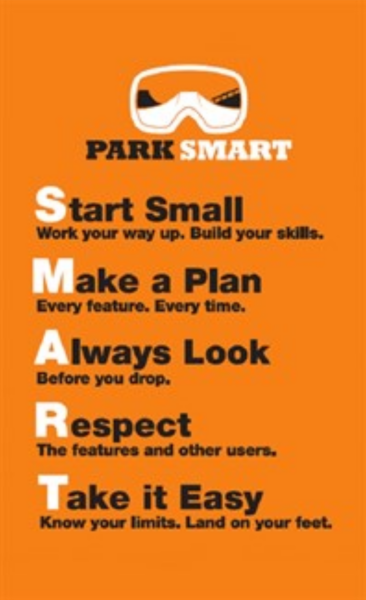Be familiar with the type of lift you are riding, and ask for help if you need it.
Mountain Education
Lift Education
Trail Markings




North Carolina Skier Safety Act
Skiing and riding can be enjoyed in many ways. At ski areas you may see people using alpine, snowboard, telemark, cross country or other specialized ski equipment, such as that used by disabled or other skiers. Regardless of how you decide to enjoy the slopes, always show courtesy to others and be aware that there are elements of risk in skiing/riding that common sense and personal awareness can help reduce. Observe the code listed below and share with other skiers/riders the responsibility for a great skiing/riding experience.
RESPONSIBILITY CODE
- Always stay in control. You must be able to stop or avoid people or objects.
- People ahead or downhill of you have the right-of-way. You must avoid them.
- Stop only where you are visible from above and do not restrict traffic.
- Look uphill and avoid others before starting downhill or entering a trail.
- You must prevent runaway equipment.
- Read and obey all signs, warnings, and hazard markings.
- Keep off closed trails and out of closed areas.
- You must know how and be able to load, ride and unload lifts safely. If you need assistance, ask the lift attendant.
- Do not use lifts or terrain when impaired by alcohol or drugs.
- If you are involved in a collision or incident, share your contact information with each other and a ski area employee.
Winter sports involve risk of serious injury or death. Your knowledge, decisions and actions contribute to your safety and that of others. If you need help understanding the Code, please ask any ski area employee.
- To know the range of the skier’s abilities to negotiate any ski slope or trail and to ski within the limits of such ability
- To maintain control of the skier’s speed and course at all times when skiing and to avoid other skiers and obvious hazards and inherent risks including variations in terrain, snow, or ice conditions, bare spots and rocks, trees and other forms of forest growth or forest debris
- To stay clear of snow grooming equipment, all vehicles, pole lines, lift towers, signs, snow making equipment, and any other equipment on the ski slopes and trails
- To heed all posted information and other warnings and to refrain from acting in a manner which may cause or contribute to the injury of the skier or others
- To wear retention straps, ski brakes, or other devices to prevent runaway skis or snowboards
- Before beginning to ski from a stationary position or before entering a ski slope or trail from the side, to avoid moving skiers already on the ski slope or trail
- To not move uphill on any passenger tramway or use any ski slope or trail while such person’s ability to do so is impaired by the consumption of alcohol or by the use of any narcotic or other drug or while such person is under the influence of alcohol or any narcotic or any drug
- If involved in a collision with another skier or person, to not leave the vicinity of the collision before giving his name & current address to an employee of the ski area operator, a member of the ski patrol, or the other skier or person with whom the skier collided, except in those cases when medical treatment is required; in which case, said information shall be provided as soon as practical after the medical treatment has been obtained. If the other person involved in the collision is unknown, the skier shall leave the personal; identification required by this sub-section with the ski area operator
- Not to embark upon or disembark from a passenger tramway except at an area that is designated for such purpose
- Not to throw or expel any object from a passenger tramway
- Not to perform any action that interferes with the operation or running of a passenger tramway
- Not to use such tramway unless the skier has the ability to use it with reasonable safety
- Not to engage willfully or negligently in any type of conduct that contributes to or causes injury to another person or his properties
- Not to embark upon a passenger tramway without the authority of the ski area operator
- If using freestyle terrain, to know the range of the skier’s abilities to negotiate the terrain and to avoid conditions and obstacles beyond the limits of such ability that a visible inspection should have revealed
Terrain Park Education
Freestyle Terrain continues to gain popularity and proper use is important. The National Ski Areas Association and Burton Snowboards have developed the “Smart Style” Freestyle Terrain Safety initiative, a cooperative effort to continue the proper use and progression of freestyle terrain at ski areas.
Always start small by working your way up from beginner features and then advancing. Build your skills and conquer one at a time.
Every time you use Freestyle Terrain, make a plan for each feature you want to use. Your speed, approach and takeoff will directly affect your maneuver and landing.
- Observe all signage and warnings. Scope around the jumps first, not over them
- Use your first run as a warmup and to familiarize yourself with the terrain
- Be aware that the features change constantly due to weather, usage, grooming and time of day
- Do not jump blindly and use a spotter when necessary
- Respect the terrain and others
- One person on a feature at a time
- Wait your turn and call your start
- Always clear the landing area quickly
- Respect all signs and stay off closed terrain and features
- Learn and know your limits
- Land on your feet

Be sure you Know the Code: You’re Responsibility Code provides safety tips while on the slopes. Smart Style is a terrain park specific safety program that you should check out before using terrain parks.
FREESTYLE TERRAIN MAY INCLUDE HALF-PIPES, AS WELL AS TERRAIN PARKS AND TERRAIN FEATURES. THEY ARE PROVIDED FOR YOUR ENJOYMENT AND OFFER ADVENTURE, CHALLENGE AND FUN. HOWEVER, FREESTYLE TERRAIN USE, LIKE ALL SKIING AND SNOWBOARDING, EXPOSES YOU TO THE RISK OF SERIOUS INJURY. PRIOR TO USING FREESTYLE TERRAIN, IT IS YOUR RESPONSIBILITY TO FAMILIARIZE YOURSELF WITH ALL INSTRUCTIONS AND WARNINGS AND TO FOLLOW “YOUR RESPONSIBILITY CODE”.
Risk Warning
Inherent risks inevitably accompany winter sports, recreational or otherwise, such as skiing, snowboarding, and snow tubing. Upon purchase of a slope pass at Cataloochee Ski Area or Tube World:
- Guests understand slope use for any purpose is hazardous and may involve the risk of physical injury or death. Guests assume the risk of injury to person(s)/property resulting from any such inherent dangers and may not recover from any ski area operator for injuries. Inherent risks of these activities include, but are not limited to: changing weather conditions, existing and changing snow conditions, bare spots, rocks, stumps, trees, collisions (whether with natural objects, man-made objects, or other skiers), variations in terrain, the failure of skiers to ski within their own abilities, jumps, and Freestyle Terrain. Snowmaking and snow grooming may be in progress at any time.
- Guests agree to stay alert at all times, control their own speed, avoid other skiers and obstacles, comply with signage and instructions of employees, and know how to safely load, ride and unload lifts.
- Guests understand passes may be revoked at any time, without refund, due to conduct that is dangerous, improper, or constitutes fraud and/or nuisance.

